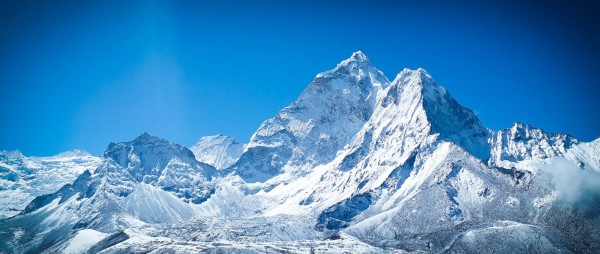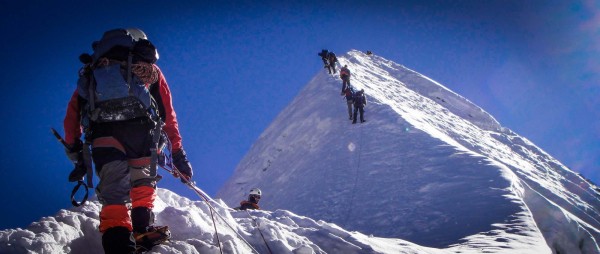Important Information
Region
Everest Region Trek
Duration
14 Days
Max Altitude 5545 meters
Best Season March, April, May and September, October, November
Activity Per Day
Itinerary
Grade
Level 3
Group Size
2 - 12 people
Transportation Flight
The highlight of the Everest Base Camp Trek
- Trek to the base of the world’s highest peak, Mt. Everest, at 5,360 m.
- Explore Sherpa's traditional villages enriched with Buddhist culture and customs.
- Visit old heritages and interesting monasteries in the backdrop of high peaks.
- Explore the beautiful alpine rhododendron and pine forests to the barren and Khumbu icefall.
- Experience the panoramic view of high mountains in the comfort of nice scenic lodges and Sherpa hospitality.
If you are looking for a different itinerary than the itinerary here, please customize your trip.
Include
All airport pick-up & drop by private vehicle (international and domestic)
Welcome dinner in an authentic restaurant in Kathmandu
National Park entrance fee and Trekking Permits
English speaking, government licensed guide with all his salary, food, drinks, accommodation, transport and insurance
Twin/double sharing accommodation in the mountain during the trekking
Three meals a day; breakfast, lunch, and dinner during the trek
Arrangement of emergency evacuation service (should need insurance for emergency evacuation and will be paid by your travel insurance company)
Trekking route maps
All necessary government taxes and service charges
1-Porter (For 2- person)
Two Way Domestic Flight to and from Lukla
Exclude
Your Nepal visa fees and 2 passport size photos
All the International airfare from and to Kathmandu
All meals and Accommodation/Hotel in Kathmandu
Food and accommodations in case of early arrivals from the trek or late departures from the airport
Your extra personal expenses during trek such as (laundry, baggage charge, phone calls, battery recharge, bar, and beverage bill, boiled or bottled water, hot and cold shower, extra porter, etc)
Tips for the trekking crew
Extra expenses due to flight delays, strikes, weather condition or any event out of our control
Route Map

Important Information
CHECKLISTS FOR EVEREST BASE CAMP TREK
- Valid passport (valid for six months from the date of your trip)
- MasterCard, Visa Credit, and Debit Cards are accepted in Nepal. However, some cash is highly recommended.
- Mobile (if your cell phone is from CINGULAR USA or ATNT (USA) operators, then your cell phone will work in Nepal.)
- Clothing (Layered clothes, windproof and waterproof jackets, fleece pullovers, thermal base layers, hiking pants, shorts, headwear, footwear, and other items according to your needs)
- Personal Items and Toiletries (First-Aid Kit, Iodine tablets or a UV purifier to treat water, Sun Protection)
- Travel and Health Insurance
- Trekking gear and equipment(if you have your own trekking gear and equipment, such as trekking poles, sleeping bag, and shoes, then you can bring them; else you can rent them in Thamel, Kathmandu). Read more for trekking gears and peak climbing gears.
Guiding, Food, and Lodging
In Nepal, all trekking supplies - Teahouse trekking means staying and eating in local lodges. We stay in single rooms where possible, but often you will have to share. Rooms are basic, normally just a bed with a pillow, blankets. A few have electric lights and all have a spacious dining room-lounge. We eat at teahouses and, although the food is usually plentiful and delicious, the menu is not extensive. They offer a variety of potatoes, rice and noodle dishes, as well as soup and seasonal vegetables. Beers and local spirits are often available, but that will be at your own cost. A variety of cereals, bread, and egg dishes are generally available for breakfast. There are also snacks available such as basic biscuits, chocolate, and soft drinks and in some areas, you will find fresh fruit in season. It is normal to meet your porter in the teahouse where you will stay overnight. So, pack your necessary things in your own day pack.
Dress code for visiting Monasteries and Temple in Nepal.
- Shirt (either half or full sleeve)
- Full pants/long skirts
- Any type of shoes with socks
- No Hats, No Umbrella, No Slippers, No t-shirts, No short skirt, and No half-pants
- Photographs allowed in the courtyard only.
Note regarding itineraries
Although we generally adhere to the schedule, the itinerary is subject to change for numerous reasons beyond our control, including weather and terrain conditions, suitable campsite availability, and the group's general fitness level. It is important to understand that our trek is logistically complex and it is not unusual that adjustments be made. Our guide will orient you each evening to the following day's plan; their good judgment is the key to the long history of successful treks that Himalayan Wander Walkers has led till now. Please remember that our ability to make adjustments as needed helps to ensure that your trek is successful.
Frequently Asked Question
Yes, the Everest Base Camp Trek can be customized to meet your needs. We can modify the itinerary based on your preferences, whether you want to shorten or extend the trek or add extra rest days. Just let us know what you're looking for, and we’ll be happy to accommodate your wishes: “Customize Your Trip.”
The Everest Base Camp (EBC) Trek is considered moderately difficult, with the primary challenge being the high-altitude environment. While the trek does not require any technical mountaineering skills, it reaches altitudes up to 5,555 meters at Kalapatthar, where altitude-related issues can arise. Good physical fitness and proper acclimatization are crucial for a successful trek.
Yes, having a guide is highly recommended for the Everest Base Camp trek. The trail traverses remote and rugged areas, and a guide will ensure safety, smooth navigation, and proper acclimatization. Guides also provide valuable insights into the local culture, history, and landscapes, and they can assist with any issues, such as changing plans due to weather-related flight delays in Lukla.
Yes, you need two special permits for the Everest Base Camp Trek: the Everest National Park Entry Permit and the Khumbu Pasang Lhamu Rural Municipality Entrance Permit. These permits allow you to access the region and trek in the Everest area. Read more about permits and their costs for EBC.
Yes, you might get altitude sickness, as it is a common concern on the EBC trek, as you’ll reach elevations above 5,000 meters. To help with acclimatization, the itinerary includes rest days at Namche Bazaar (3,400 m) and Dingboche (4,410 m). Staying hydrated, eating well, and ascending gradually are the best ways to prevent altitude sickness. If you experience symptoms like dizziness or headaches, inform your guide immediately so they can follow the necessary protocols.
Along the EBC route, you will stay in teahouses and lodges that provide simple but comfortable rooms and traditional local food. These accommodations offer a great chance to experience Sherpa culture while ensuring a restful stay during the trek.
Yes, internet access is available during the Everest Base Camp trek, though it’s limited. Mobile network coverage is available through Ncell or NTC, and many lodges offer Wi-Fi. Additionally, Everest Link provides prepaid broadband wireless services in select areas along the trail.
When packing for the trek, you'll need sturdy trekking shoes, warm clothing, a sleeping bag, water bottles, sunscreen, a hat, energy snacks, and a small first-aid kit. Make sure to pack light but wisely to stay comfortable during the trek, keeping in mind the varying weather conditions. Read more about the packing list for EBC.
Yes, there are other exciting treks in the Everest region. The Gokyo Lakes Trek provides stunning views of Everest and its neighboring peaks, offering a more tranquil and less crowded experience. The Three Passes Trek is more challenging, taking you across three high-altitude passes with amazing Himalayan vistas. Both treks offer unique experiences that are ideal for those looking for something different from the classic EBC route.
No questions found matching your search. Try different keywords or browse all questions above.
| {{type.min}} - {{type.max}} Pax {{type.name}} - {{type.desc}} | {{type.display_price}} per people |
Extra prices:
Let us help you decide Inquiry
You might also like

- 12 days
- Everest Region Trek
Gokyo Lake Trek
“Gokyo lake trek is the perfect destination in the Everest region for those who detest crowds and expect jaw-dropping scenery” Gokyo lake trek is the second most popular destination in Everest Region which offers an alternative to the traditional trek to Everest base camp. The...




